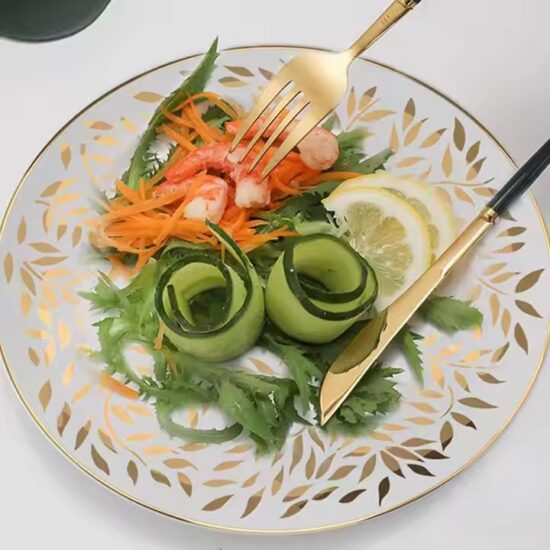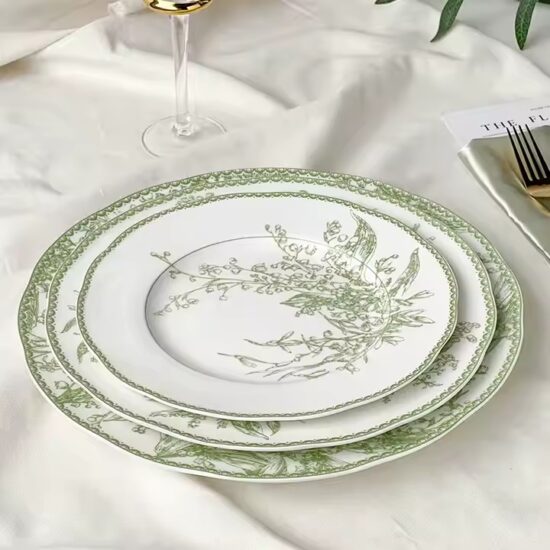bob@nbdho.com
How Raw Materials and Processing Techniques Shape High-Quality Ceramic Plates
Raw Material Selection and Processing Techniques for Ceramic Plates
Introduction
The quality of a ceramic plate starts long before it enters the kiln—it begins with raw materials and how they are processed. Whether for daily use or luxury tableware, the choice of materials and preparation methods directly affect the strength, appearance, thermal resistance, and safety of ceramic plates. This article explores the critical materials and techniques used in ceramic plate production.
1. Common Raw Materials Used in Ceramic Plates
The core components for ceramic plate production are:
-
Kaolin (China Clay):
The primary clay used for its purity, whiteness, and high firing temperature. It provides structural integrity and a smooth finish. -
Ball Clay:
Adds plasticity and workability to the clay body, making it easier to shape. -
Feldspar:
Acts as a flux, reducing the melting point during firing and helping form a glassy phase that increases strength. -
Quartz (Silica):
Controls shrinkage and improves thermal stability. It contributes to hardness and glaze fit. -
Additives (e.g., Alumina, Bentonite):
Improve specific properties such as thermal shock resistance, strength, or bonding ability.
2. Factors to Consider When Selecting Raw Materials
Choosing the right materials depends on the intended product characteristics:
-
Color and Whiteness: High-grade kaolin is used for premium whiteware.
-
Plasticity: Essential for shaping processes like pressing or jiggering.
-
Firing Temperature Compatibility: Materials must match the kiln settings to avoid defects.
-
Glaze Compatibility: Raw body and glaze must work together chemically and thermally.
-
Cost and Availability: Sustainable sourcing can lower production costs and environmental impact.
3. Processing Techniques of Ceramic Plate Raw Materials
Once the materials are selected, they undergo several processing steps:
A. Crushing and Grinding
Raw materials are crushed and ground into fine particles for consistent blending. Particle size directly influences the surface smoothness and uniformity of the plate.
B. Blending
Each material is proportioned and mixed, often using ball mills or high-speed mixers. Blending ensures a homogeneous mixture with predictable behavior during shaping and firing.
C. Slurry Formation (for slip casting)
The blended powder is mixed with water to form a slip—a pourable slurry used in mold casting.
D. De-airing
Whether using clay body or slip, de-airing removes air bubbles that can cause cracks during firing. Vacuum pugmills or filter presses are commonly used.
E. Aging (Optional)
Aging the prepared clay allows water and particles to distribute evenly, improving workability and plasticity.
4. Importance of Raw Material Quality Control
Inconsistent or low-quality raw materials can lead to:
-
Warping and cracks during firing
-
Poor glaze adherence or color issues
-
Reduced strength and thermal shock resistance
-
Safety risks if impurities are present
That’s why quality control labs are essential for testing properties like particle size, plasticity, shrinkage rate, and chemical composition before large-scale production.
5. Environmental Considerations in Material Sourcing
Modern ceramic manufacturers are also focusing on eco-friendly material sourcing, including:
-
Using locally available clays to reduce transportation emissions
-
Recycling unfired scraps and glazes
-
Replacing harmful components (e.g., lead-based materials) with safe alternatives
This aligns with sustainability goals and improves global market acceptance.
Conclusion
Raw material selection and processing play a fundamental role in producing high-quality ceramic plates. For manufacturers, understanding these variables ensures better product consistency, performance, and customer satisfaction. For wholesalers and buyers, knowing the origin and processing of ceramics adds transparency and confidence when sourcing products.
Whether you’re developing a new ceramic line or choosing a supplier, start by asking: What’s in the plate, and how was it prepared? The answer makes all the difference.

